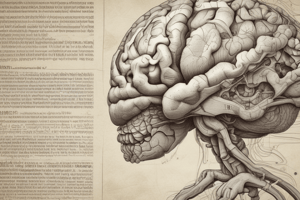Podcast
Questions and Answers
What is the name of the long narrow tube that connects the third ventricle with the fourth ventricle?
What is the name of the long narrow tube that connects the third ventricle with the fourth ventricle?
- brainstem tunnel
- ventricular canal
- cerebral aqueduct (correct)
- meningeal duct
Which ventricles are connected by the cerebral aqueduct?
Which ventricles are connected by the cerebral aqueduct?
- Lateral ventricles
- Third and fourth ventricles (correct)
- Fourth and lateral ventricles
- Third and lateral ventricles
What is the shape of the structure that connects the third and fourth ventricles?
What is the shape of the structure that connects the third and fourth ventricles?
- Circular
- Narrow and long (correct)
- Oval
- Rectangular
What is the function of the cerebral aqueduct?
What is the function of the cerebral aqueduct?
Where is the cerebral aqueduct located?
Where is the cerebral aqueduct located?
Which bone is NOT part of the formation of each orbit's wall?
Which bone is NOT part of the formation of each orbit's wall?
How many bones are involved in forming the walls of each orbit?
How many bones are involved in forming the walls of each orbit?
Which of the following bones is NOT paired with the maxillary bone in forming the orbit's wall?
Which of the following bones is NOT paired with the maxillary bone in forming the orbit's wall?
What is the name of the bone that is paired with the frontal bone in forming the orbit's wall?
What is the name of the bone that is paired with the frontal bone in forming the orbit's wall?
What is the term for a fold in the brain?
What is the term for a fold in the brain?
Which of the following bones is part of the formation of the orbit's wall?
Which of the following bones is part of the formation of the orbit's wall?
What is the term for the valley between folds in the brain?
What is the term for the valley between folds in the brain?
What is the function of ventricles in the brain?
What is the function of ventricles in the brain?
What is cerebrospinal fluid?
What is cerebrospinal fluid?
What is the purpose of the hollow fluid-filled cavities in the brain?
What is the purpose of the hollow fluid-filled cavities in the brain?
How many bones are in the skeleton of the face?
How many bones are in the skeleton of the face?
What is the Mandible bone in the face?
What is the Mandible bone in the face?
Which of the following bones is NOT part of the facial bones?
Which of the following bones is NOT part of the facial bones?
What is the function of the Mandible bone?
What is the function of the Mandible bone?
What is the study of the structure of the facial bones?
What is the study of the structure of the facial bones?
What is the name given to the air-filled sinuses that cluster around the nasal cavity?
What is the name given to the air-filled sinuses that cluster around the nasal cavity?
What is the shape of the bony cavities that hold the eyes?
What is the shape of the bony cavities that hold the eyes?
What is contained within the orbits?
What is contained within the orbits?
What type of glands are found in the orbits?
What type of glands are found in the orbits?
What type of tissue is found in the orbits, aside from the eyes?
What type of tissue is found in the orbits, aside from the eyes?
Flashcards are hidden until you start studying
Study Notes
Brain Structure
- Folds in the brain are called gyri, and the valleys between them are called sulci.
- The brain has hollow fluid-filled cavities called ventricles.
- The third ventricle connects with the fourth ventricle through a long narrow tube called the cerebral aqueduct.
Orbit Bones
- The walls of each orbit are formed by parts of seven bones: frontal, sphenoid, zygomatic, maxillary, palatine, lacrimal, and ethmoid bones.
- The orbits are cone-shaped bony cavities that hold:
- The eyes
- The muscles that move the eyes
- Fat
- The tear-producing glands
Facial Bones
- The skeleton of the face consists of 14 bones.
- The mandible is the largest, strongest bone in the face.
Paranasal Sinuses
- The air-filled sinuses are called paranasal sinuses because they cluster around the nasal cavity.
Studying That Suits You
Use AI to generate personalized quizzes and flashcards to suit your learning preferences.



